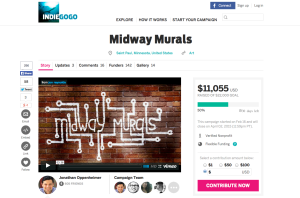Indiegogo vs Kickstarter: You Make the Call
 Crowdfunding is the practice of funding a project or venture by raising monetary contributions from a large number of people, typically via the Internet. This practice gives people the opportunity to raise money for creative projects. By submitting an online donation, contributors are not allowed to become investors or shareholders, rather the project creators retain all control over products and services.
Crowdfunding is the practice of funding a project or venture by raising monetary contributions from a large number of people, typically via the Internet. This practice gives people the opportunity to raise money for creative projects. By submitting an online donation, contributors are not allowed to become investors or shareholders, rather the project creators retain all control over products and services.
By the end of 2013, a cumulative $1.17 billion dollars had been raised using crowdfunding, and is projected to reach $4.35 billion by the end of 2015.
Indiegogo and Kickstarter are two of the most popular crowdfunding websites.
KICKSTARTER VS. INDIEGOGO
Indiegogo and Kickstarter are both successful funding platforms. When using either, the user posts a project, sets a financial goal, creates a timeframe to reach that goal, and the community pledges money to support the project. While very similar, both Indiegogo and Kickstarter have their own strengths.
Project Categories: Kickstarter only accepts projects in the specific categories of:
- Art
- Comics
- Dance
- Design
- Fashion
- Film
- Food
- Games
- Music
- Photography
- Publishing
- Technology
- Theater
 In comparison, Indiegogo is more relaxed in terms of its project categories. Indiegogo will accept anything from trip fundraising to personal wishes.
In comparison, Indiegogo is more relaxed in terms of its project categories. Indiegogo will accept anything from trip fundraising to personal wishes.
Monetary Policy: Another difference between these two crowdfunding sites is their monetary policy.
Kickstarter enacts an “all-or-nothing” policy, meaning if a project does not reach its financial goal, the project doesn’t get any of the money pledged. Therefore, when using Kickstarter, it is important to set the goal at the bare minimum to increase your likelihood of reaching it. Kickstarter also charges a 5% fee if the project is successful.
In comparison, if a project does not reach its financial goal on Indiegogo, the user can still keep the money raised. In addition, Indiegogo only charges a 4% fee if the project reaches its goal. However, if the goal is not reached, Indiegogo will charge 9% of the funds raised.
Stats: Overall, Kickstarter attracts more traffic, accumulates more pledges, and has more dollars pledged than Indiegogo. When looking at success rates,
- Kickstarter projects achieve success 43.4% of the time;
- Indiegogo projects achieve success 9.8% of the time. But keep in mind even failed projects on Indiegogo get to keep the money raised.
The average crowdfunding campaign is $5,000 on Kickstarter and $3,700 on Indiegogo. The average visits per month on Kickstarter are 23 million and 13.4 on Indiegogo.
Website Design: Indiegogo seems easier to use but with a slightly more cluttered format. Indiegogo also links to Facebook and Twitter easily. Kickstarter has a simpler look, and has more options regarding individual formatting.
CHARACTERISTICS OF SUCCESSFUL CAMPAIGNS
9 average no. of levels of reward offers
35 average length of campaign (days)
8 average no. of updates from successful founders
17 average no. of comments
$87 average pledge
$10- $25 most popular contribution reward level
3:04 average length of video (minutes)
609 average no. of words on campaign description

Speak Your Mind